Mugen Souls Z is the sequel to Mugen Souls and adopts a good portion of the systems in place in that game, changing them slightly for easier of use, as well as making them simpler to understand. The gameplay has been described as a mix of Hyperdimension Neptunia mk2 and the Disgaea series.
Exploration
The game adopts a similar system to its prequel, where players are tasked with going from planet to planet, searching for the ultimate god for each one. There is also a central hub, where players can purchase items, talk to NPCs and even access the Mugen Field.
G-Castle
The G-Castle is the main hub for the player and their party, functioning similar to the main hubs from the Disgaea games. There are a multitude of services available, ranging from the various shops to a hot spring. Only the weapons and clothing shops are available from the beginning of the game, with the other services opening as you progress through the main story.
- Weapons Shop - Can buy items, weapons and armor for your characters
- Clothing Shop - Can buy clothing for your characters, which are both cosmetic and can help increase stats earned upon leveling
- Notice Board - Functions similar to an encyclopedia, showing various things unlocked, as well as the bestiary
- Hot Spring - Provides a temporary stat buff for characters
Planet to Planet
The main method of exploration in Mugen Souls Z will be whenever the player goes from planet to planet in search of the ultimate gods. Enemies are on the field and if you come into contact with one of them, a battle will commence. In addition to that, the game progresses by going to events, which are shown on the field as sideways hourglass symbols, and there are also chests.
Battle System
The battle system in Mugen Souls Z is turn-based, with the turn order based on the speed of the characters. Players will see enemies on the field and will initiate battle by coming into contact with them. There can be up to four characters in an active party, as well as a sub party, allowing for players to swap out characters during battle.

Every character, when their turn comes, is able to move a certain span, indicated by the circle beneath their feet. Once they are in position, pressing X will bring up the command menu, where that character can attack, use skills, defend, as well as other actions. The character can attack anything that's in range of their normal attack command or their skills.
Captivate
Captivate is the same as Moe Kill in the previous game, where Syrma can use her power to try and make an enemy into a Peon or item. Players get three opportunities to use "Fetish Poses" to try to change an enemy into a peon or an item, and if wanted, enrage them. Unlike the previous game, there are bars that show you if you will succeed or not.
In addition to regular enemies, Captivate can also be used on the planets themselves. Once you unlock this ability, you will find various points marked on your map, which are numbered. By hitting L2, you will see the same numbers, but with a vague objective that is needed in order to use Captivate on that Planet Part.
Each objective is different, as sometimes all you need is to give an item, while other times you will need to use Peon Change as with normal enemies. Some Planet Spots are locked until you progress in the storyline, so it won't be possible to completely finish a planet on the first visit.
Ultimate Soul
Ultimate Soul is the equivalent to the Peon Ball from Mugen Souls, which is an ultimate attack that only Syrma can use. Its power is completely dependent on the number of Shampuru you have, and it can only be activated if you have uses left, as well as PP.
There is one problem, though, with the Ultimate Soul attack, as it can Overload and damage your party as well. This has a chance of happening whenever the Overload gauge reaches 10%. Fortunately, this bar empties whenever you go back to the G-Castle or use the Ultimate Soul attack.
Blast-Off/Crystals
Another aspect of the battle system is Blasting Off, which are attached to skills. This allows the player to launch enemies, both around the battlefield and even into the air, allowing them to knock them around into other enemies and sometimes crystals, both large and small.
Crystals are extra modifiers, of sorts, in battles that provide both beneficial and negative effects. These crystals can be Captivated, as well as destroyed by depleting their health, although they can't be attacked directly. Instead, players need to use Blast-Off to knock enemies into them, which will slowly deplete their health each time they are hit.
G-Castle Battles
Fighting with your party isn't the only combat you will see, as you're introduced to fighting with the G-Castle at the beginning of the game. This system uses a rock-paper-scissors like style, where certain attacks are effective against others. Battles are 1-on-1, where the sole objective is to deplete the enemy's HP to zero.

For example, you choose to Attack with G-Castle, but the enemy chooses to Reflect. If this scenario plays out, then the attack you sent will be reflected back at you and you will take damage instead. However, if you chose to use Pierce in this situation, then the attack will negate the Reflect and deal damage to the enemy.
- Attack - Big damage, but can be negated using Reflect or Drain
- Fast Attack - Attack before enemy, lower strength of their Pierce, but can be negated using Reflect or Drain
- Pierce - Weak attack, but goes through Reflect
- Drain - Absorbs Attack/Fast Attack and heals either HP or SP
- Reflect - Returns Attack/Fast Attack back at the enemy, but Pierce goes through it
In addition to the above, there are other actions that can be used, such as being able to heal G-Castle. It's impossible to figure out which kind of action the enemy will use, but at the beginning of each turn, the enemy will say something. What they say can be used to determine whether they'll attack or not, so you'll need to pay attention.
Mugen Field
Mugen Field is an optional dungeon, of sorts, where the player can fight through a series of random battles to level up. It is a total of 100 floors, with Rest Stops on levels 10, 30, 60 and 100. At first, players will only be able to go up to level 10, with the rest of the floors being unlocked by purchasing with tickets at the Mugen Shop in G-Castle.
At the Rest Stops, players can strengthen their characters by unlocking more Peon Classes, opening more equipment slots, level skills, as well as more. When the player begins, they can choose to bet Mugen Points, with the bet determining the strength of the monsters encountered. Also, they can place restrictions on themselves, such as prohibiting the use the items, which in turn ups the rewards gained after each battle.
Equipment/Customization
Each character can equip one weapon and one piece of armor, which can be bought at shops, dropped from enemies (either by defeating them or using Captivate) or even found in treasure chests. As you progress in the storyline, more equipment will be available in shops, but not all of them can be bought with G, the game's currency.
Later pieces of equipment will require items as well. For example, the third tier of equipment is when this starts coming into practice, as you will need to have various items in your inventory, in addition to the required G, in order to purchase the weapon or armor. Once you reach a certain point in the game, you will be able to level equipment using G, with G Up (earned from the Mugen Field) can increase the level limit.
Characters can also equip clothing, which can be found by the same methods as equipment. Every character has multiple slots in which they can equip these pieces of clothing. What clothes do is increase the stat aptitudes, which will increase the number of stats that a character earns when they level.